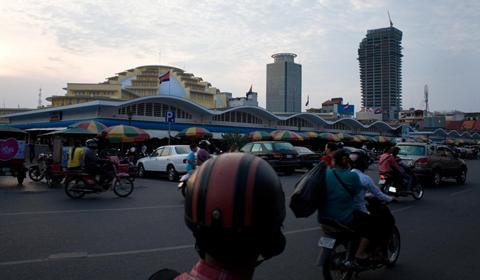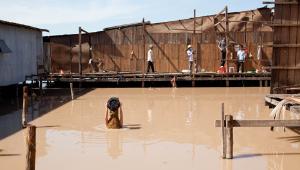 |
| Phnom Penh’s skyline is fast seeing new skyscrapers, prompting artists to create works commenting on the rapid urbanization in the city. (Photo: VOA – Yong Yen Nie) |
April 18, 2012
Yong Yen Nie | Phnom Penh
Voice of America
Cambodia’s capital city, Phnom Penh, was once known as the “Paris of the East”
for its resemblance to the famous European city. During French colonial
rule, Phnom Penh boasted spacious villas with French courtyards that
were homes and reception venues to both the wealthy French and Khmers.
The mansions and villas are now faded memories of the city’s former grandeur
before it was left in shambles from the Khmer Rouge regime. Many of
these former symbols of sophistication and wealth are now abandoned and
waiting to be demolished to make way for skyscrapers.
Skyscrapers are Cambodia’s new symbols of prosperity and modernity. While the city skyline is still largely spartan, all that is about to change, with Cambodian Prime Minister Hun Sen endorsing the construction of more skyscrapers in the city by Korean and Chinese contractors.
But this push toward a moden city has a cost in lost history, vanishing natural areas and evictions.
To increase the development, the government has recently filled in
Boeung Kak Lake, which is located in the heart of the city, and evicted
thousands of households living in the surrounding areas.
The ensuing controversy has prompted a movement among Cambodian
artists and photographers to respond to the rapid urbanization of Phnom
Penh.
Going against the tide, this group is concerned with the rapid
urbanization of Phnom Penh and the mass demolition of its
colonial-influenced buildings. In response, they have created and
exhibited works to comment on the issue.
Erin Gleeson, a curator and researcher who has lived in Cambodia for a
decade, said there is a strong pattern among Cambodian artists to
document and archive the city’s landscape, with the anticipation that it
could become unrecognizable in years to come.
“Almost 80% of the local artists in advanced practices are
committedly making commentaries on the rapid urbanization of Cambodia.
These local artists are responding to the change in their lifestyles,
culture and environment and some of them are also expressing their
personal experiences as they are also residents near the lake that is
now vanished,” she said.
Gleeson added that this movement of artists is not pre-planned, but
the works seen so far have turned out to be a cohesive collection that
presents a similar view.
“Phnom Penh is a flat city, and has never been a concrete city. But,
as it develops, the artists here mourn for the loss of that landscape
that they are so used to. It is an irony, as we feel that some things
are dying, even though the city is growing,” she said.
Among the artists that have prominent works on the subject include
Kim Hak, a photography artist that has exhibited several projects in and
out of Cambodia, mainly on people living in and among colonial
buildings in Phnom Penh.
“More often than not, a new building or skyscraper is constructed at
the expense of existing buildings that have historical and social
values, including schools and hospitals. I believe that the colonial
buildings should co-exist with the new ones, instead of changing Phnom
Penh’s landscape entirely,” he said.
Another artist, Khvay Samnang, has worked extensively in producing
art works to express his views on the vanishing lakes in Phnom Penh’s
city centre. He has recently exhibited a series of photographs of
himself standing in the middle of the now-gone Boeung Kak lake and
pouring earth over his body as the shot was being taken.
“My work is for the people. I use my body to react towards the loss
of lakes situated in the heart of the city. I am not trying to change
the government’s mind about how they should develop this country but
rather, I am expressing my experience of this loss and be critical about
this issue,” he said.
Khvay said he is not against the government developing the land in
Phnom Penh. But, he says it has to be done with proper urban planning.
“Filling the lake with earth will result in environmental consequences
such as increased floods in Cambodia in future years,” he explained.
Responses to these artists’ work have been encouraging. Kim said his
photographs of colonial architecture have helped raise awareness of
preserving some heritage monuments. “When these photographs are
exhibited in Phnom Penh, UNESCO wanted to use some of them as exhibits
to discuss with the government on preserving these buildings,” he said.
Gleeson said the local artistic community did not produce art works
to quickly change people’s minds, but rather to engage with the
community. “In their own individual ways, these artists want to be
initiators of conversations, and not want to let things pass without
saying something,” she said.


No comments:
Post a Comment